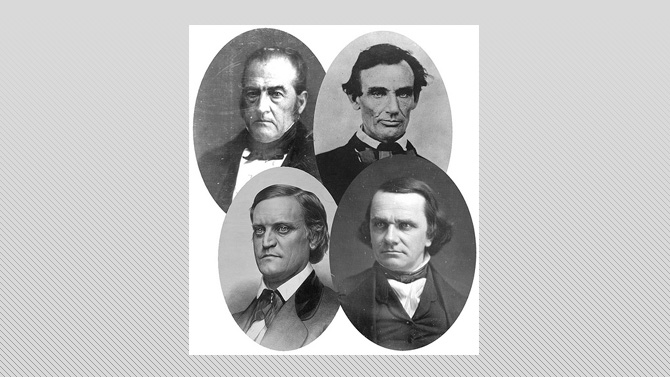


Through Dec. 16: Lincoln-Douglas
September 23, 2016
Library hosts exhibition on Lincoln-Douglas debates, 1860 campaign
The University of Delaware Library will present the exhibition “The Lincoln-Douglas Debates and the Campaign of 1860: The Road to the Lincoln Presidency” through the current election season.
The exhibition is being held in conjunction with programming by the library, the Center for Political Communication and the Department of Communication around the presidential and vice presidential debates, and the Delaware Debates to be held on campus.
The exhibition displays material from the extensive Lincoln Collection in the library’s Special Collections Department.
The exhibition, which was curated by Timothy Murray, Head of Special Collections Department, will be on view in the Lincoln Exhibit Case on the second floor of the Morris Library from Sept. 23 through Dec. 16 during the Morris Library’s regular hours.
In 1858, Abraham Lincoln, by then a well-regarded lawyer and former one-term Republican congressman (1847-49) from Illinois, challenged Democratic U.S. Sen. Stephen Douglas for his senate seat. Douglas agreed to an unprecedented series of debates held in towns across Illinois focusing on the issue of slavery.
Although Douglas was re-elected, Lincoln gained national attention for his opposition to slavery, which led to his nomination as Republican presidential candidate in 1860.
At the 1860 Republican convention, Lincoln was seen as more moderate than his major opponent, Sen. William Henry Seward of New York, who was a staunch abolitionist. In addition, Lincoln addressed other issues such as developing railroads and immigration that made him attractive to states such as Pennsylvania and New Jersey with concerns in addition to slavery.
After much political maneuvering, Lincoln won on the third ballot. The Republican platform was a compromise between abolitionists and more laissez-faire delegates. It opposed the expansion of slavery into the Western territories without condemning it in the South, criticized the judicial activism of the Dred Scott decision, denounced John Brown’s raid at Harper’s Ferry, endorsed a federal homestead law and a transcontinental railroad, and opposed stricter naturalization laws.
Douglas ran on the Democratic ticket but without the support of the Southern wing of the party which split off, believing that Douglas was weak on preserving slavery. At a separate convention, the Southern Democrats nominated then-Vice President John C. Breckenridge as their candidate.
Another splinter group, calling themselves the Constitutional Union Party, nominated John Bell of Tennessee, a wealthy slaveholder, as their candidate for president. This party called for moderation and believed that the best way out of the present difficulties that faced the nation was to take no stand at all on the issues that divided the North and the South.
But the time for compromise was past and Lincoln won the presidency with virtually no support in the South. His closest pursuer was Breckinridge with Douglas coming in dead last. When the popular vote was tallied, 60 percent of those who cast ballots voted for a candidate other than Lincoln.
As soon as the election results were known, Southern states, led by South Carolina, began seceding from the Union. By the time of Lincoln’s inauguration, in March 1861, seven states had left the Union and a month later, the Civil War commenced.
The election of 1860 might very well be the most significant American presidential election in history. With the sharp divisions between Donald Trump and Hillary Clinton, between the two major parties, and within the American citizenry as a whole, the election of 1860 offers startling parallels to the 2016 presidential election.
The “Lincoln-Douglas Debates and the Campaign of 1860: the Road to the Lincoln Presidency” presents an array of materials documenting the debates, the campaign, and the election, offering a unique historical l look at this important series of events that led to the most volatile and divisive period in American history. An online version of the exhibit will be available at this website.
Contact Us
Have a UDaily story idea?
Contact us at ocm@udel.edu
Members of the press
Contact us at 302-831-NEWS or visit the Media Relations website

